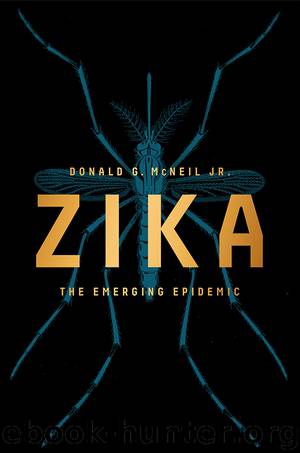Zika by Donald G. McNeil

Author:Donald G. McNeil
Language: eng
Format: epub
Publisher: W. W. Norton & Company
Published: 2016-07-04T16:00:00+00:00
10
The Proof
ON FEBRUARY 1, 2016, when the WHO declared its emergency based on the possibility that Zika caused microcephaly, reporters asked WHO officials exactly what evidence was needed to be sure it did.
Initially, both Dr. Bruce Aylward, who was in charge of the response, and Dr. Heymann, the advisory committee chairman, gave the same answer: a large case-control study.
Scientists in Latin America, they said, were already recruiting pregnant women into one. They had signed up about 5,000, mostly in Colombia, some in Brazil, some elsewhere; they had to be pregnant and to have come up positive on tests for the virus. Those were the “cases.” They were also signing up “controls”: a roughly equal number of pregnant women who did not have Zika. They would try to match the two cohorts as closely as possible: same ages, same races, same neighborhoods, same income levels, same medical histories, especially regarding previous dengue or chikungunya infections. (Obviously, if a woman in the control group got Zika during the study, she would be shifted to the case group.)
They would monitor the two groups until their babies were born, and compare the results. If the Zika group had far more babies with microcephaly than the control group, they could definitively say Zika was the cause.
This was a “prospective cohort study,” the gold standard in epidemiology. The women enrolled first were due to start giving birth in May and June, Dr. Aylward said, so final proof would have to wait until that data was ready.
In fact, the science moved forward much faster.
On March 31, without any fanfare, the WHO made a subtle but important change to one sentence on the face of its weekly Zika situation report. It read:
“Based on observational, cohort and case-control studies there is strong scientific consensus that Zika virus is a cause of GBS, microcephaly and other neurological disorders.”
“Strong scientific consensus” marked a shift from previous reports, which said it was “highly likely” Zika was a cause.
Then on April 13, the CDC made it definitive. Its director, Dr. Frieden, scheduled an afternoon press conference with the leaders of his Zika team and declared unequivocally, “It is now clear: the CDC has concluded that Zika does cause microcephaly.”
It was “an unprecedented association” in medicine, he added. “Never before in history has there been a situation where a bite from a mosquito can result in a devastating malformation.”
What led the agencies to change their minds about waiting for the big study?
A series of small studies.
The number of cases of confirmed microcephaly in Brazil had just kept growing. Before the CDC announcement, it had passed the 1,000 mark, with nearly 900 clustered in the northeast.
Microcephalic babies were by then being born not just in Brazil but in Colombia, in Panama, in Martinique, and in the Cape Verde Islands, not to mention the cluster discovered retrospectively in French Polynesia. Each cluster had followed a Zika outbreak about nine months earlier.
Separate teams of doctors—in Brazil, in the United States, even in Slovenia—had found Zika virus in
Download
This site does not store any files on its server. We only index and link to content provided by other sites. Please contact the content providers to delete copyright contents if any and email us, we'll remove relevant links or contents immediately.
| Cell Biology | Developmental Biology |
| Entomology | Marine Biology |
| Microbiology | Molecular Biology |
| Biostatistics |
Sapiens: A Brief History of Humankind by Yuval Noah Harari(14254)
The Tidewater Tales by John Barth(12609)
Mastermind: How to Think Like Sherlock Holmes by Maria Konnikova(7228)
Do No Harm Stories of Life, Death and Brain Surgery by Henry Marsh(6891)
The Thirst by Nesbo Jo(6829)
Why We Sleep: Unlocking the Power of Sleep and Dreams by Matthew Walker(6618)
Life 3.0: Being Human in the Age of Artificial Intelligence by Tegmark Max(5475)
Sapiens by Yuval Noah Harari(5294)
The Longevity Diet by Valter Longo(5021)
The Body: A Guide for Occupants by Bill Bryson(4975)
The Rules Do Not Apply by Ariel Levy(4863)
The Immortal Life of Henrietta Lacks by Rebecca Skloot(4526)
Animal Frequency by Melissa Alvarez(4395)
Why We Sleep by Matthew Walker(4361)
The Hacking of the American Mind by Robert H. Lustig(4319)
Yoga Anatomy by Kaminoff Leslie(4306)
All Creatures Great and Small by James Herriot(4233)
Double Down (Diary of a Wimpy Kid Book 11) by Jeff Kinney(4208)
Barron's AP Biology by Goldberg M.S. Deborah T(4100)
